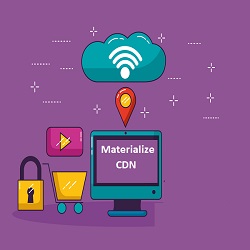What is Materialize?

Materialize is a Frontend Framework based on Google’s Material Design. It is well-established and in relation to other CSS frameworks, is more highly opinionated on how UX elements should behave and look, which is to be expected, since the purpose of Materialize is to help you conform your code to Material Design. Continue reading to learn how Materialize and CDN work together.
Before delving into the beneficial relationship of Materialize and CDN, let’s first set down some definitions:
What is a content delivery network?
A content delivery network is a network of servers interlinked for the purpose of delivering content and online assets as quickly, efficiently, reliably, cheaply, and securely as possible. In order for content delivery networks to more easily communicate with each other, bridging servers are placed at exchange points to work with each other.
These bridging servers are called internet exchange points. These are the primary locations where Internet service providers or ISPs connect in order to provide each other access to traffic from different networks. A Best CDN provider is able to reduce costs and transit times for data delivery by providing these bridging servers or internet exchange points.
The closer an end user is to a content delivery network that he or she is trying to access, the faster that CDN will deliver assets to him or her. Thus, the speed and connectivity of a CDN is also geographically relative.
Materialize CDN
Materialize CDN is a Frontend Framework based on Google’s Material CDN Design.
Material Design, created and designed by Google, is a design language that interweaves classic principles of eye-catching and successful design with forward looking concepts of technology and innovation. Google’s goal in mind when they were developing the system was to allow for a unified user experience across all their platforms and products.
Some of Material Design’s selling points are that it (1) is guided by print design methods; (2) incorporates ideas of motion; (3) is extremely flexible; (4) and that it is highly responsive to cross-platform use.
By being guided by print design methods, Material Design uses topography, grids, space, scale, color, and imagery, to create “hierarchy, meaning, and focus” that is creates an appealing immersive user experience.
By incorporating ideas of motion, through subtle visual feedback to use such as clicks or scrolling, and coherent transitions, focuses end-user attention and maintains seamless continuity in the experience as a whole. On-screen elements transform and reorganize in relation to their immediate and changing environment, creating a transformative and fluid user experience.
Flexibility is manifested through a custom code base further modified through the use of components, plug-ins, and design elements which allows for the uniqueness of each brand’s expression. Material Design can be considered as more personalized platform of design language compared to other systems in CSS, Java, or HTML.
Responsiveness to cross-platform use a huge selling point for Material Design. It is an undeniable trend that more and more end-users are accessing websites and content on different platforms: whether it be on desktops, laptops, pads, or on mobile. For a website to be truly responsive in this day and age, it must be adaptive to the platform the end-user is using and able to provide at the very least, a comfortable user experience.
How does Materialize CSS and CDN work together?
Materialize can be installed on your website using content delivery networks. By utilizing the high speed data transmission and delivery capabilities of content delivery networks, you can now start using or start learning how to use Materialize CSS for your website.
Materialize and CDN go together! Indeed, the framework is extremely light at 29kb and provides built-in features that cover modern support, easy to use features, parallax elements, flow texts, cards, hoverable items & objects.
Implementing the Materialize framework is also simple — it can be installed by downloading the materialize.min.css and materialize.min.js files on your computer and integrating it with the HTML code. For the CDN (Content Delivery Network) based version, the materialize.min.css and materialize.min.js files can be integrated into the HTML code directly from the CDN.
We’ve already laid down that content delivery networks, if utilized correctly, provide for a highly effective and efficient data asset transfer superhighway. To reduce loading time and lag, content delivery networks can provide your assets with the oomph and boost they need to get going.
Furthermore, we’ve established that Materialize is a frontend framework that incorporates formidable classic design principles with innovative and forward-looking user experience technologies.
Materialize and CDN if taken as a pair can create a formidable team to establish an amazing online presence.
BelugaCDN is a five-star rated content delivery network provider that can provide top-notch online acceleration at even better prices. If you’re looking for a content delivery network to work with your website’s Frontend Framework, BelugaCDN is the provider to choose. Visit their website at belugacdn.com for more information.
Power-up your Content Delivery
30 Day Free Trial Cancel Anytime